Put your growth on autopilot
GrowSurf is modern referral program software that helps product and marketing teams launch an in-product customer referral program in days, not weeks. Start your free trial today.
90 percent of startups fail.
Want to be a part of the 10 percent? Start by building a product that satisfies a market need. One that a specific audience will be willing to pay for.
It’s as difficult as it sounds, I know. The market, after all, is always evolving. New products are always coming out of the woodwork. Customer behaviors and expectations shift. And the competition is growing fiercer by the day.
How do you carve your way through startup success?
Here’s an idea: Build in public.
Chances are you’ve encountered the term “build in public” or “building in public” at least a few times.
And it means exactly how it sounds. But it can also mean something more. If you want to make this work, it has to be something more.
Simply put, building in public is when a startup builds a product or service in public and invites people to see their progress while also engaging them.
With that said, building in public can also be many things. It’s about storytelling. It’s about empowerment. It’s also a mindset as much as it is a strategy. And it’s ultimately about transparency.
Microbrave's definition pretty much nails it:
“Building in public is a foolproof strategy for makers and founders to cultivate community, get user feedback regularly, and stay accountable. But it can be scary too — you don't know how to start or have anxieties about being vulnerable and facing judgment. We've been there too, and we're here to help.”
Microbrave couldn’t be more right about the “scary” part. After all, when you’re building in public, you’re putting yourself out there. It’s terrifying levels of vulnerability. Especially when you don’t know half of what you’re doing (which is the case with most startup founders).
But the real question is: Does it work?
You bet it does.
Here are the reasons why building in public can be good for your company.
Building in public gets people to trust you more.
When you’re sharing your wins and losses, your strategy and processes, your fears, methods, and systems, and who knows what else, you’re showing everyone that you have nothing to hide.
It takes a lot of courage to put yourself out there. Your audience knows that and will appreciate you more for having the guts to put yourself on the hook. And by being transparent about what you do, you’re creating the impression that you have people’s best interests in mind.
And when people trust you more, they are more likely to buy what you have to offer.
Besides, sharing your wins, whether big or small, lets them know that you’re building something worthwhile.
Does that mean sharing your losses and setbacks will produce the opposite effect? Not really. People know instinctively that nothing truly worthwhile can be achieved without failure.
Bannerbear founder, Jon Youngfook knows how it’s done.

Product-market fit is when you have built something that a particular market is willing to pay for. And you can’t gain real traction in your startup until you find product-market fit.
The thing about product-market fit is that it’s incredibly hard to find.
Thankfully, building in public is an effective strategy to pull it off.
By sharing your progress with everyone, you’re inviting your followers (and non-followers) to share their thoughts, ideas, and suggestions on how to build your product. This presents opportunities for you to validate your ideas with people who matter the most—your product's potential users. You can gather insights and data from those engagements and then use them to make the tweaks and improvements necessary to build something they’ll be willing to pay for.
At the end of the day, building in public is storytelling in action. After all, sharing your progress creates tension.
Will you achieve your MRR target by the end of the year? Or will you come up short?
Building in public creates a curiosity gap, which can help build interest around your startup journey, and eventually your product or solution.
Best of all, when you’re building in public, you’re taking people on a compelling journey that makes them emotionally invested in your brand.
Besides, people love stories because they convey purpose. As Simon Sinek says, “People don’t buy what you do, they buy why you do it.”
If you want to build something worthwhile, you need to be accountable to your goals.
Easier said than done. After all, building a startup can be overwhelming work.
Want to stay true to your vision and achieve constant progress in your startup venture? Turn your followers into accountability partners.
When you’re keeping your followers in the loop, you know they’re counting on you, and you’re likely to do your best so that you won’t let them down.
Of course, your followers are not just there to cheer you on. They’re also there to ask hard questions.
Besides, sharing your progress, thoughts, and ideas makes them more “real,” not just things that exist within your head.
Before you build in public, you need to know what you’re getting into. Here are some disadvantages of building in public you need to be aware of.
When you’re building in public, you’re providing competitors opportunities to steal your ideas. Worse, they may take those ideas and refine them in ways that will give them the edge over you.
By sharing your, say, pirate metrics, you’re giving competitors the information advantage. They’re learning from you, but you’re not learning from them.
Building a product or solution is hard. Finding product-market fit is even harder. If you want to succeed in your startup journey, you need to stay focused.
While building in public keeps you on your toes, it can also derail your focus. The time you’re spending updating your followers on the progress of your MVP is time you’re spending not working on your MVP.
When you’re building in public, there’s a lot of context switching involved. And context switching is the death of deep work.
Also, if you’re not careful, criticisms and suggestions may throw you off your vision and brand purpose. So before you put yourself out there, make sure your vision and brand purpose are clearly defined and communicated.
Building in public may make you accountable to your goals. It can help you gain helpful advice and illuminating insights. The problem? It can be nerve-wracking.
If you’re not comfortable being in the spotlight, building in public may turn you into a ball of anxiety.
You will receive feedback you’re not ready for. You will be criticized. And the fear of failing in public will constantly sit in your gut like a rock.
If you want to do this, you need to be able to roll with the punches. Because if you do this right, you can turn your anxiety into a productivity-booster.
Building in public is as tough as it sounds, but thankfully, the advantages far outweigh the disadvantages.
But how do you make this work? Here are tips and best practices that will help you succeed in your build in public strategy.
Building in public is not just about sharing your stats, insights, and progress. It’s also about sharing how you feel.
I already mentioned that building in public is storytelling in action, right? If you want to tell a compelling story, emotions have to be a part of the equation.
Tell them how you feel. Tell them about your struggles and your doubts. Celebrate your wins, however small.
Besides, people naturally root for the underdog. They’re not going to cheer you on or be inspired by what you do if you have the personality of a rock. If you want to gain support and build a community, show some vulnerability. Show them you’re human.
If you want your build in public strategy to pay dividends in the long run, give them a clear roadmap of what your goals are and where you’re heading.
As mentioned earlier, people love an underdog story. They are more likely to get invested in your journey if you show them bit by bit how you’re improving and refining your product, rather than showing them the polished and final version outright.
So give them a detailed account of your journey. Keep them updated with your core metrics and show them actual numbers. Post screenshots of your process or internal messages that showcase company culture. Don’t just share your product ideas. Tell them why those ideas are important to you and how they fit into your overall goals.
Some founders or marketers make the mistake of only talking about their product when they’re building in public.
Do it this way and you're likely to come off like you’re bragging.
If you're going to share your progress, do it in ways that will deliver value to your audience.
Otherwise, why should they care?
Don’t just specify your struggles. Don’t just tell them how you were able to navigate and overcome those struggles. Create a resource, guide, or template that will turn all the insights you’ve gained from the experience into actionable information. Share step-by-step guides on how you have solved your problems. Found a resource that proved helpful to you in your journey? Share it with them.
Building in public doesn’t mean you have to spend all day on social media.
Want to achieve breakthroughs in your business venture? Want to come up with ideas that will move the needle for your business?
Take the time to think things through on your own.
Besides, studies show that solitude can make you more creative.
While gathering data and insights from other people is essential, your most important choices and breakthroughs will be made without outside influences.
Newsletter
Here are a few examples of open startups that have found success from the “build in public” approach.
GrowSurf’s story is an underdog story through and through. After reaching only $66 MRR with our v1 product years ago, you would think we would be down for the count.
Well, not so fast. GrowSurf is now at $34k MRR and at a little over $400k ARR, and well on our way towards reaching our goal of $40k MRR and $1 million ARR. And we’re doing it 100% bootstrapped!
As an open startup, we share revenue and core metrics with the public. Let me show you those core metrics one by one.
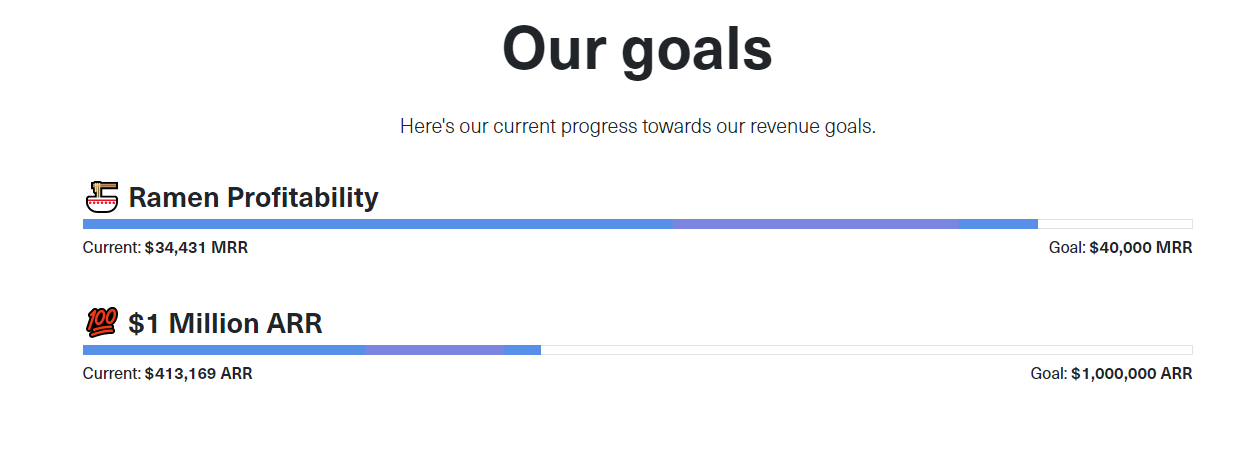
GrowSurf’s usage stats have seen steady progress over the past three months.

GrowSurf’s website traffic has been seeing steady growth too!
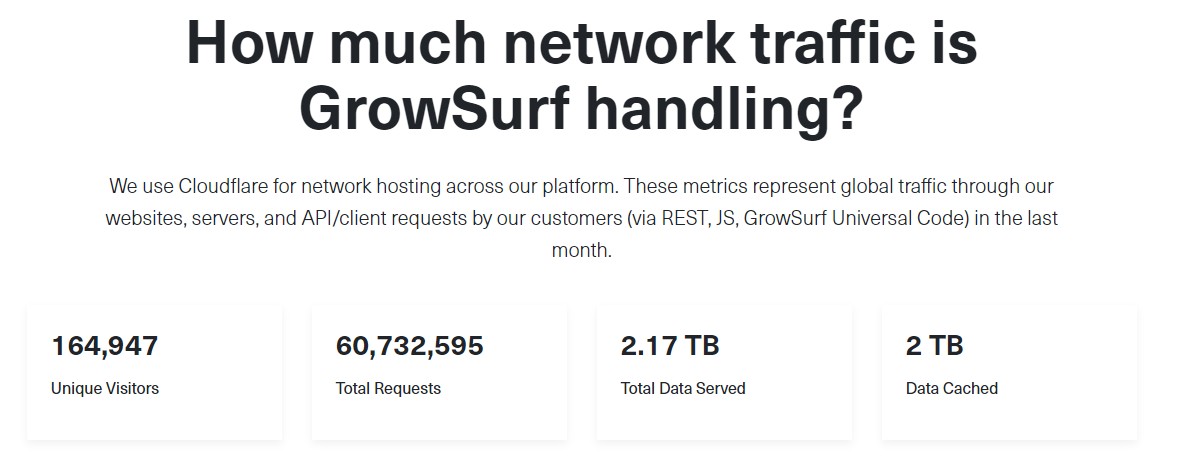
Note that the stats shown above might already be outdated (screenshots were taken in September 2021). To see GrowSurf’s stats in real-time, follow the startup’s progress at: https://growsurf.com/open
CopyAI went from $1 to $50,000 MRR organically in four months.
How did they do it? By building in public. And they did it by posting monthly updates on Twitter.
Here’s CopyAI’s July update, as tweeted by the startup’s founder (@PaulYacoubian) himself:
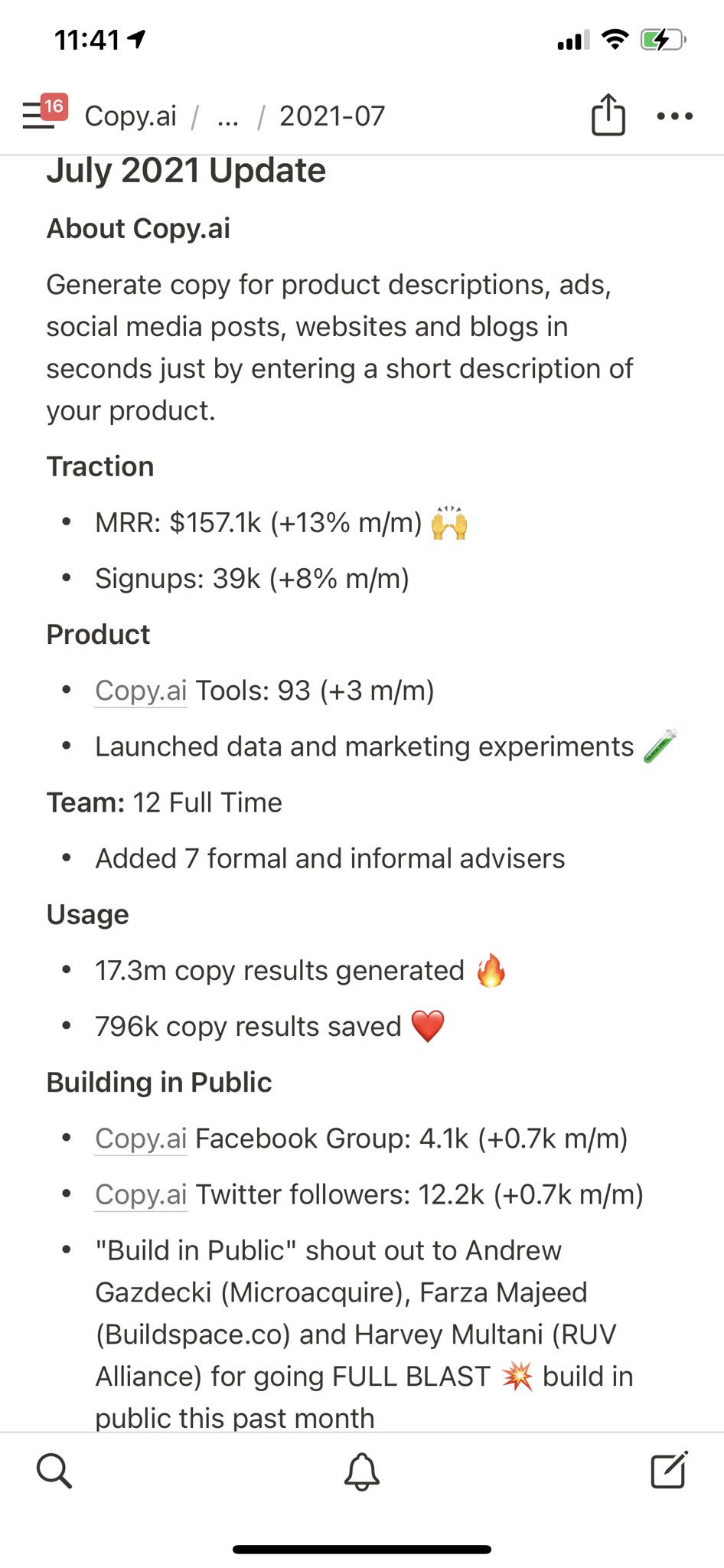
And Paul shared every milestone that got them there. Like that time when CopyAi reached $30k MRR:
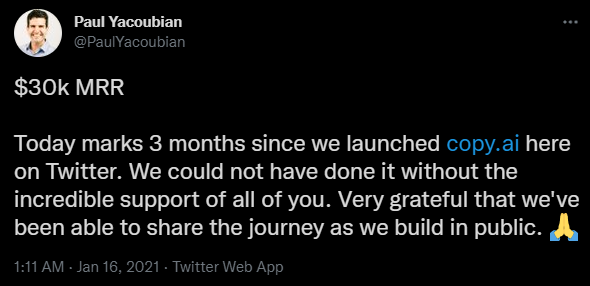
How did CopyAI nail their build in public strategy?
By sharing their wins, losses, and their learnings with the public.
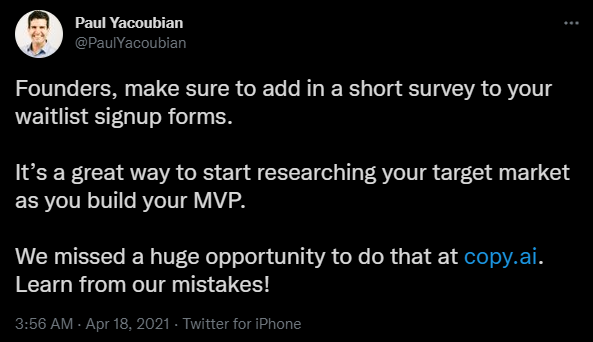
In a recent podcast interview, Paul Yacoubian shares his thoughts on how building in public has helped them reach their goals:
“On Twitter, your followers are the community that you build around yourself. You will attract people that are interested in what you tweet about. The easiest way to get started is to engage with people that you want in your community. If you prioritize trying to add value to that community, they will start following you. It creates this flywheel effect. We would get more followers every time we launched a side project.”
Buffer is a company that has been transparent in everything they do. They've been transparent about salaries and diversity over the years. And true to form, they’ve been transparent about their product roadmap too.
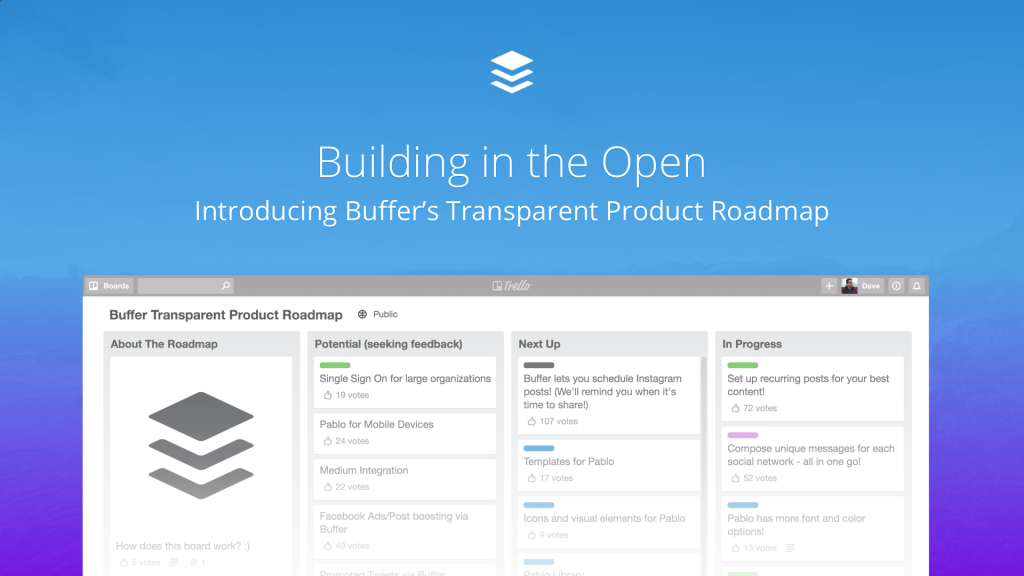
[Image source: Buffer]
Buffer’s approach to building in public wasn’t relegated to social media. They also created a blog post series called Building Buffer “to help people and learn from others who have had similar experiences.”
Here’s the blog post that launched that series:
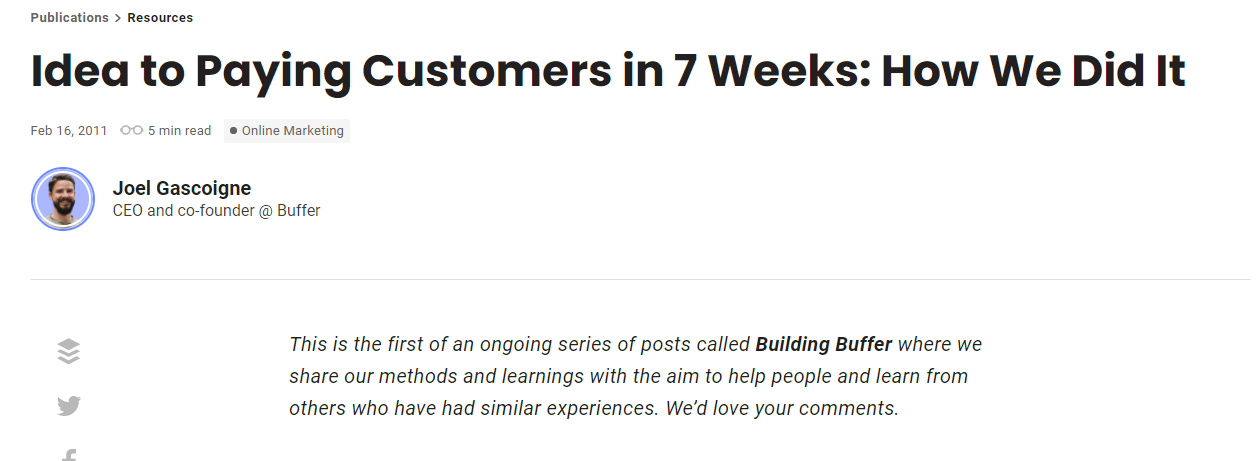
Buffer gained the most traction when it launched its Open blog in late 2013. As you can see from the graph below, transparency made Buffer a unicorn in the startup world.
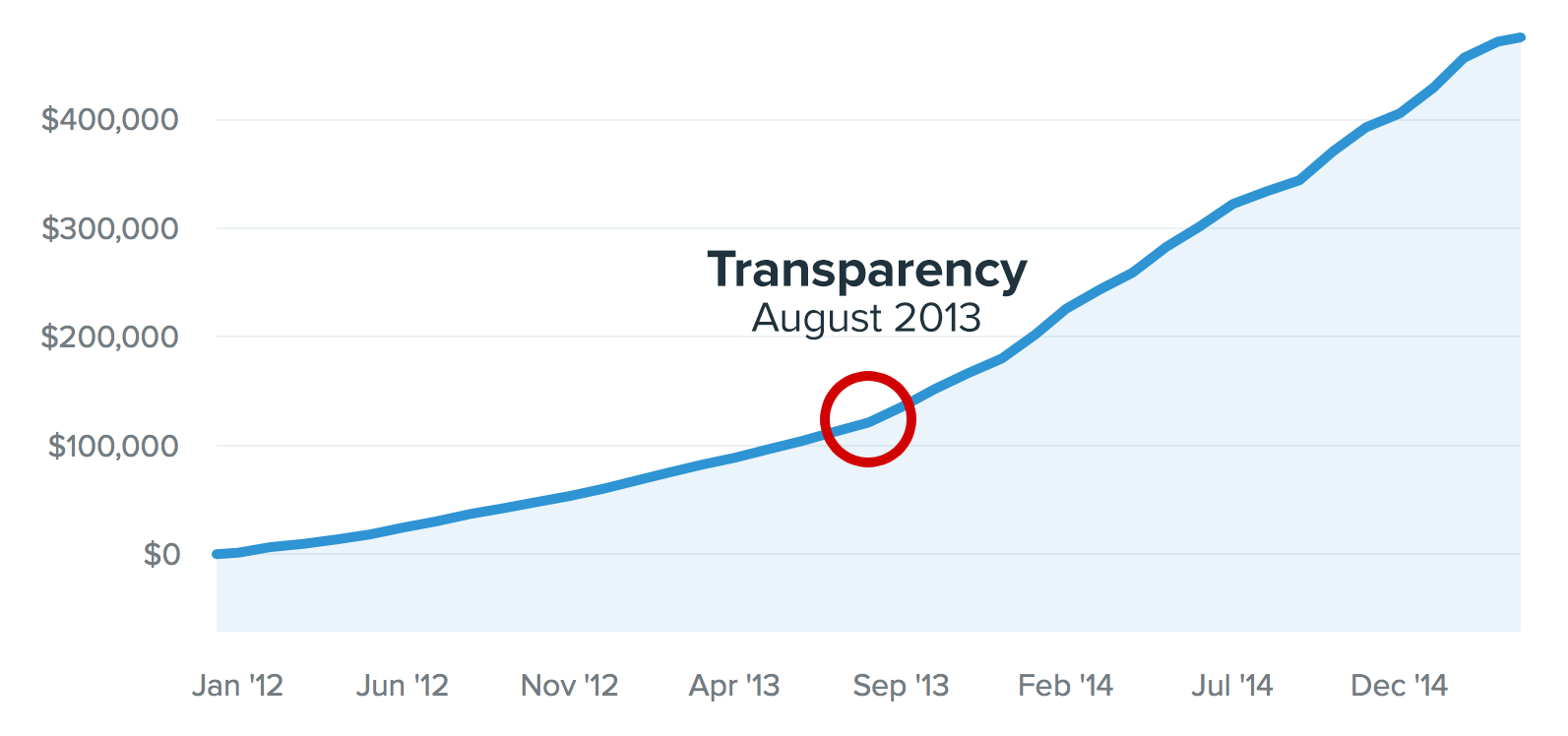
To this day, Buffer remains the gold standard on how to achieve success using the build in public model.
Building in public is a long-term game. You aren’t likely to get results overnight, but it’s going to pay big dividends for your brand in the long run. It takes real courage to put yourself out there, but if you do this right, building in public will not only help you find product-market fit, it’s also going to generate more word of mouth and referrals.
In summary, building in public will:
Sign up for a free trial of GrowSurf to lower your customer acquisition costs, increase customer loyalty, and save gobs of time.


GrowSurf is modern referral program software that helps product and marketing teams launch an in-product customer referral program in days, not weeks. Start your free trial today.
Inside a winning SaaS content strategy. In this blog we cover everything you need to know about content brainstorming, scaling production and promotion.
Increasing customer loyalty leads to retained customers, more revenue and increased brand value. Building on customer loyalty makes a big difference to growth.
Want to reach a larger audience, meet your customer needs, and increase revenue? Find what undifferentiated marketing is and how it can help your business.